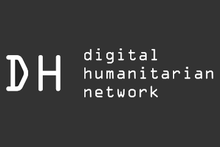Digital Humanitarian Network
The Digital Humanitarian Network is a network-of-networks, enabling a consortium of Volunteer and Technical Communities (V&TCs) to interface with humanitarian organizations that seek their services.[1] As a community-based network, the DHN has a growing list of member-groups and organizations.
 | |
| Abbreviation | DHNetwork |
|---|---|
| Formation | April 9, 2012 |
| Type | Volunteer Network |
| Legal status | Association |
| Location |
|
Region served | Worldwide (Online Community) |
| Leader | Andrej Verity & Patrick Meier |
Key people | Cat Graham; Kate Chapman; Luis Capelo; Willow Brugh |
| Website | digitalhumanitarians |
Mission
The Digital Humanitarian Network’s (DHNetwork) website was launched on April 9, 2012 by its co-founders:
- Andrej Verity,[2] OCHA
- Patrick Meier,[3] iRevolution
The purpose is to support humanitarian organizations in their disaster response efforts around the world.[4] The network consists of member V&TCs (entities that manage networks of technically trained volunteers around the globe, who can be activated to backstop disaster response operations and produce information with limited turn over time). These groups have a wide range of skills from GIS mapping, crowdsourcing, and data analysis and collection, to volunteer management and process design. The DHNetwork puts groups that have existed for years under one umbrella and provides a single outlet for traditional responders to access the organizations.[5]
History
In recent crises, like the 2010 Haiti earthquake, members of online technology communities have cooperated to gather, process and share crucial information resources to help aid agencies on the ground, without contributing to 'data noise', by focusing on the information needs of aid agencies and other responders. This collective action was recognised and legitimized after the Haiti earthquake when volunteer communities established a 'network of networks' with the aim of concentrating the abilities online responders on the most urgent information needs during each new emergency.[6]
The DHNetwork, has been created precisely in order to coordinate their action[7][8] with, at its heart, a coordinator's group. The network brings together many of the major V&TCs thereby increasing their visibility both amongst themselves and amongst the traditional humanitarian community, and has defined a clear activation process between the VT&Cs and coordinators, so that traditional organizations are able to submit one request and rely on the DHNetwork to build a solution team with the relevant V&TC members. DHNetwork also makes it simpler for organizations to define collaborative projects with the V&TCs.[9] As Jacobo Quintanilla underlines it: "humanitarian actors too, are finally adopting some of these tools (i.e. crowdsourcing and mapping tools) more systematically within their work, relying on input from affected populations", citing initiatives such as the DHNetwork as an example "to create important inroads in the way aid organisations leverage technology and the power of VT&Cs".[10]
Digital Humanitarian Network Coordinators
The DHNetwork is composed of several members who form Solution Teams when the network is activated. DHNetwork Coordinators review activation requests and rapidly liaise with the different volunteer & technical teams who are members of Digital Humanitarians to build a Solution Team best able to act on a request. The Coordinators aim to provide a response to every request within 24 hours.
The Current Coordinators of the DHNetwork are: Heather Milton, Evert Bopp, Oludontun Babayemi, Hilary Nicole Zainab Ervin,
Past Coordinators of the DHNetwork are:
2014 Justine Mackinnon, Helen Campbell,
2013
- Cat Graham, Humanity Road
- Kate Chapman, http://hot.openstreetmap.org/
- Luis Capelo a volunteer member of the StandBy Task Force (not official representation)
- Willow Brugh, Geeks Without Bounds
Previous activations
In the past year, the DHNetwork has been activated five times by OCHA South Sudan, ACAPS, OCHA Philippines, Samoa government and UNHCR (Syria). In each case, the requesting entity sent a central request to the DHNetwork. These efforts resulted in such things as rapid data collection, social media filters to augment traditional assessments, and a translation of the UNHCR Syria portal into Arabic allowing regional civilians to access normally inaccessible information.
1) OCHA South Sudan. Searching the internet for 3 days looking for reports, articles, and data, the team collected 15,271 unique pieces of information.
2) ACAPS. The team surveyed the internet for Democratic Republic of Congo-related assessments, population statistics, historical IDP numbers, humanitarian events, and indicator values. The group also created several maps.
3) OCHA Philippines. The United Nations Office for the Coordination of Humanitarian Affairs (OCHA) activated the DHNetwork on December 5, 2012, to track the real-time effects of Typhoon Pablo in the Philippines and collect all relevant tweets about the typhoon; identify pictures and videos of damage/flooding shared in those tweets; geolocate, time stamp, and develop real-time maps of displaced people, fatalities, crop damage, broken bridges.[11] The team searched through over 20,000 social media messages within 24 hours of the crisis for photos and videos. Results were compiled and organized in a structured database. The Solution team used a variety of methods ranging from automated algorithms to micro-tasking. They used Geofeedia to identify all relevant pictures/videos that were already geo-tagged by users, PyBossa and a free and open-source microtasking platform. UN OCHA published a map that is entirely sourced from social media analysis.[4]
4) UNHCR (Syria). Translation of UNHCR’s English portal to Arabic, which allows responders, refugees (2 million), internally displaced populations, the global public, and professionals easier access to information.
See also
- Relief 2.0
- Digital humanitarianism
References
- DHNetwork Main website for the consortium: digitalhumanitarians.com
- "Verity Think" Blog from Andrej Verity.
- Patrick Meier's Biography from Blog iRevolution.
- "Digital Disaster Response to Typhoon Pablo" by Patrick Meier.
- "Activation Successful: The Digital Humanitarian Network Simulation at ICCM" at TechChange.
- "How Crisis Mapping Saved Lives in Haiti" by Patrick Meier.
- Article: "Teaming up with the Digital Humanitarians"
- "Big Data: A Natural Solution for Disaster Relief" by Kathryn Kelly.
- "Digital Humanitarian Network"
- "Disaster communications: covering the ‘last mile’" by Jacobo Quintanilla.
- "Big Data: A Natural Solution for Disaster Relief" by Mike Smitheman.